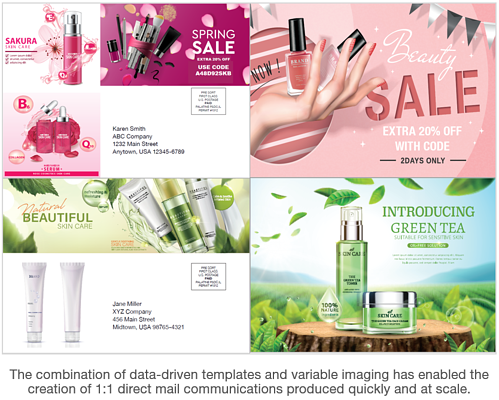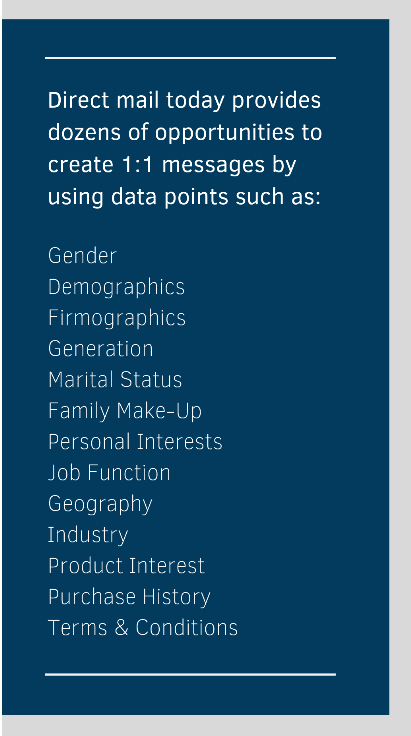 As marketers well know, consumers expect consistent, personalized communications from the brands they interact with.
As marketers well know, consumers expect consistent, personalized communications from the brands they interact with.
Marketers themselves are accustomed to the simplicity and breadth of personalization digital marketing channels provide. Far fewer, however, are aware of the vast degree to which direct mail can be personalized with the same relative ease.
As brands continue to collect richer and more relevant customer data, leverage variable imaging to use this data to create highly targeted direct mail communications that resonate on the individual level but are produced at massive scale.
Why Personalize?
Personalization is now table stakes when it comes to competing for customer attention, not to mention share of wallet.
In fact, in a recent study by Adobe, 42% of respondents said they get annoyed when their communications aren’t personalized. What’s more, 52% of consumers and 65% of business buyers each said they are likely to switch brands if a company didn’t personalize its communications to them.
So skip personalization, in any of your marketing channels, and you run the risk of putting off your customers, or worse yet, losing them altogether.
Personalization Opportunities

With variable printing, personalization in direct mail takes on all shapes and sizes from images to content to offers. Using any combination of demographic, geographic, psychographic and behavioristic data, brands can go beyond creating one message for mass segments to instead delivering messages with one-to-one relevancy.
Here are a few ways you can use your customer data to create those one-to-one direct mail pieces.
Imagery
Photos and graphics grab attention with images often being the first thing that capture our eye. In the few seconds you have to engage the recipient, irrelevant imagery can send your piece straight to the recycling bin.
Instead, use variable printing to feature relevant images such as items that correlate with previous purchases or images of products abandoned in the shopping cart.
One of the most effective uses of imagery in marketing is lifestyle imagery. However, when using lifestyle imagery, it’s imperative to feature pictures that are reflective of your recipient, whether that’s by gender, geography, etc. Prior to variable imaging, the use of lifestyle imagery at scale was difficult. Now, its simply a matter of mapping the template to the appropriate image for individual relevancy.
Content
Once a recipient chooses to engage with your direct mail piece relevant copy creates interest, builds understanding, and helps form a purchasing decision.
Variable imaging marries dynamic content (i.e. that which is variably printed) to static content. Dynamic content can range from the replacement of specific words to whole blocks of text. Thus, enabling brands to elevate beyond the standard Hello John and instead deliver messaging tailored to the recipient’s specific interests and needs. Additional opportunities include individualizing the call to action and personalizing to specific sales or customer service representative or call centers.
Offers
With variable printing, offers can take varying forms, from purchase discounts to the reminder of an unused credit. With the sophistication this technology provides, you can tailor offers to a granular level where next-door neighbors receive differing offers based on their specific needs or interests.
Leverage your first-party data to create relevant offers based on the individual’s prior engagement and purchasing history to create a catalyst that will generate more purchases. Track customer usage with unique promo codes or bar codes for online and in-store attribution.
The amount of personalization that can be featured on any one piece is driven largely by your direct mail format. Our customers use personalization to varying degrees. An increasing number are using personalized triggered postcards as part of their retargeting programs.
A growing trend is to layer these postcards into their abandoned cart recovery strategies where they feature images of the items left behind. Personalization is also being used heavily in customer retention strategies. For one automotive manufacturer we produced a six-page self-mailer that featured 33 individual points of personalization. This booklet was sent to vehicle owners at the point when they were starting to think about their next vehicle purchase and resulted in a 5.23% customer loyalty growth.
Consumers today expect the brands they engage with to know who they are. And, they expect these brands to deliver tailored communications regardless of channel, both online and off.
Because of variable printing, direct mail is no longer one-size fits all.
Are you taking full advantage of all the opportunities direct mail provides? If you’re not using variable imaging in your direct mail campaigns or if you want to see how you can take variable imaging further, let’s talk.
{{cta(‘355bf0fe-6702-4960-94b7-8e261b40b077’)}}
Related Articles:
Case Study: Automotive Manufacturer Drives Customer Loyalty With Personalized 1:1 Direct Mail
3 Ways to Use Direct Mail As A Catalyst For Digital Engagement
